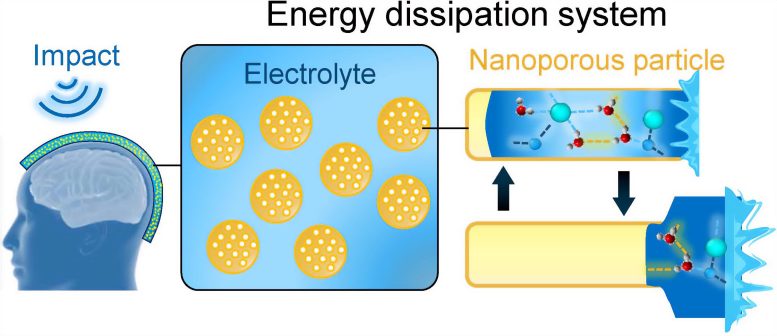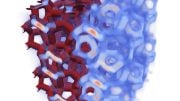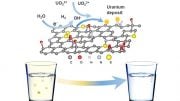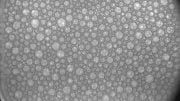
An advanced nanofoam material promises improved protection and comfort for sports gear, with potential applications in car safety systems and wearable medical devices. The innovative material overcomes the limitations of traditional nanofoam, providing a flexible and comfortable solution that can withstand multiple impacts. (Artist’s concept dramatizing the “liquid” safety cushion.)
New breakthrough in material design will help football players, car occupants, and hospital patients.
A significant breakthrough in the field of protective gear has been made with the discovery that football players were unknowingly acquiring permanent brain damage from repeated head impacts throughout their professional careers. This realization triggered an urgent search for better head protection solutions. Among these innovations is nanofoam, a material found inside football helmets.
Thanks to mechanical and aerospace engineering associate professor Baoxing Xu at the University of Virginia and his research team, nanofoam just received a big upgrade and protective sports equipment could, too. This newly invented design integrates nanofoam with “non-wetting ionized liquid,” a form of water that Xu and his research team now know blends perfectly with nanofoam to create a liquid cushion. This versatile and responsive material will give better protection to athletes and is promising for use in protecting car occupants and aiding hospital patients using wearable medical devices.
The team’s research was recently published in the journal Advanced Materials.

A diagram illustrating how a liquid nanofoam cushion responds to an impact. Credit: Contributed by B. Xu
Upgraded Nanofoam: Advancements and Potential
For optimal safety, the protective foam sandwiched between the inner and outer layers of a helmet should not only be able to take one hit but multiple hits, game after game. The material needs to be cushiony enough to create a soft place for a head to land, but resilient enough to bounce back and be ready for the next blow. And the material needs to be resilient but not hard, because “hard” hurts heads, too. Having one material do all of these things is a pretty tall order.
The team advanced their work previously published in the Proceedings of the National Academy of Sciences, which started exploring the use of liquids in nanofoam, to create a material that meets the complex safety demands of high-contact sports.
“We found out that creating a liquid nanofoam cushion with ionized water instead of regular water made a significant difference in the way the material performed,” Xu said. “Using ionized water in the design is a breakthrough because we uncovered an unusual liquid-ion coordination network which made it possible to create a more sophisticated material.”

Associate Professor Baoxing Xu in the UVA Department of Mechanical and Aerospace Engineering. Credit: Tom Cogill
Enhanced Performance and Comfort
The liquid nanofoam cushion allows the inside of the helmet to compress and disperse the impact force, minimizing the force transmitted to the head and reducing the risk of injury. It also regains its original shape after impact, allowing for multiple hits and ensuring the helmet’s continued effectiveness in protecting the athlete’s head during the game.
“An added bonus,” Xu continued, “is that the enhanced material is more flexible and much more comfortable to wear. The material dynamically responds to external jolts because of the way the ion clusters and networks are fabricated in the material.”
“The liquid cushion can be designed as lighter, smaller, and safer protective devices,” said associate professor Weiyi Lu, a collaborator from civil engineering at Michigan State University. “Also, the reduced weight and size of the liquid nanofoam liners will revolutionize the design of the hard shell of future helmets. You could be watching a football game one day and wonder how the smaller helmets protect the players’ heads. It could be because of our new material.”
Overcoming Traditional Nanofoam Limitations
In traditional nanofoam, the protection mechanism relies on material properties that react when it gets crunched, or mechanically deformed, such as “collapse” and “densification.” Collapse is what it sounds like, and densification is the severe deformation of foam on strong impact. After the collapse and densification, the traditional nanofoam doesn’t recover very well because of the permanent deformation of materials —making the protection a one-time deal. When compared to the liquid nanofoam, these properties are very slow (a few milliseconds) and cannot accommodate the “high-force reduction requirement,” which means it can’t effectively absorb and dissipate high-force blows in the short time window associated with collisions and impacts.
Another downside of traditional nanofoam is that, when subjected to multiple small impacts that don’t deform the material, the foam becomes completely “hard” and behaves as a rigid body that cannot provide protection. The rigidness could potentially lead to injuries and damage to soft tissues, such as traumatic brain injury (TBI).
By manipulating the mechanical properties of materials — integrating nanoporous materials with “non-wetting liquid” or ionized water — the team developed a way to make a material that could respond to impacts in a few microseconds because this combination allows for superfast liquid transport in a nanoconfined environment. Also, upon unloading, i.e., after impacts, due to its non-wetting nature, the liquid nanofoam cushion can return to its original form because the liquid is ejected out of the pores, thereby withstanding repeated blows. This dynamic conforming and reforming ability also remedies the problem of the material becoming rigid from micro-impacts.
Extended Applications of Liquid Nanofoam
The same liquid properties that make this new nanofoam safer for athletic gear also offer a potential use in other places where collisions happen, like cars, whose safety and material protective systems are being reconsidered to embrace the emerging era of electric propulsion and automated vehicles. It can be used to create protective cushions that absorb impacts during accidents or help reduce vibrations and noise.
Another purpose that might not be as evident is the role liquid nanofoam can play in the hospital setting. The foam can be used in wearable medical devices like a smartwatch, which monitors your heart rate and other vital signs. By incorporating liquid nanofoam technology, the watch can have a soft and flexible foam-like material on its underside and help improve the accuracy of the sensors by ensuring proper contact with your skin. It can conform to the shape of your wrist, making it comfortable to wear all day. Additionally, the foam can provide extra protection by acting as a shock absorber. If you accidentally bump your wrist against a hard surface, the foam can help cushion the impact and prevent any harm to the sensors or your skin.
Reference: “Nanoconfined Water-Ion Coordination Network for Flexible Energy Dissipation Device” by Yuan Gao, Mingzhe Li, Chi Zhan, Haozhe Zhang, Mengtian Yin, Weiyi Lu and Baoxing Xu, 6 July 2023, Advanced Materials.
DOI: 10.1002/adma.202303759









Be the first to comment on "Innovative Liquid Cushioning Technology Promises Revolution in Safety Gear"